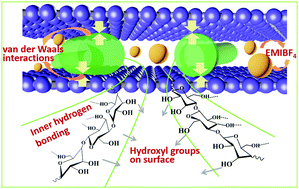Concisely modularized assembling of graphene-based thin films with promising electrode performance†
Abstract
Assembling and scaling up two-dimensional (2D) nanomaterials into macroscopic films represents an accessible fabrication and manipulation technique toward functional materials with promising mechanical and electrical characteristics, which are extremely desirable for high-performance portable and wearable electronic devices. However, inter-layer restacking seriously interrupts mass transport to the inner surfaces, strongly impeding the full realization of the merits of 2D nanomaterials in the bulk phase. In this work, we report a concise assembling strategy to form thin films with well-controlled micron thickness through the layer-by-layer vertical alignment of reduced graphene oxide (RGO) and cellulose nanofibers (CNFs) in an aqueous solution. The van der Waals interactions between the nonpolar RGO surface and the sugar unit-based backbone of CNF dominantly led to the formation of extremely compact heterostructures comprising one-dimensional (1D) and two-dimensional (2D) nanocomponents. We found that the formation of the heterostructure of CNF/RGO is an ideal method to prepare flexible and compact films; meanwhile, this led to abundant mesoporous structures and a relatively high specific surface area (up to 100 m2 g−1), good tensile strength (250 MPa), excellent conductivity (120 S cm−1) and high density (1.6 g−1 cm−3). After using such kinds of thin films as electrodes and an ionic liquid as an electrolyte without any additive, the fabricated symmetric supercapacitors delivered high volumetric double-layer capacitances of up to 120 F cm−3 with volumetric energy density of 180 W h L−1, which are among the highest values for the reported graphene or carbon-based devices. Such excellent electrode performance clearly manifests the electrolyte transport within the compact structures of these thin films, indicating the presence of substantial polar channels associated with the orientated alignments of the functional groups on the surface of CNF. Furthermore, these thin films enable vertical stacking in a Lego-like manner to form multi-layer electrodes, delivering an increased total output power approximately in proportion to the layer.

- This article is part of the themed collection: Graphene-based architectures for energy storage


 Please wait while we load your content...
Please wait while we load your content...